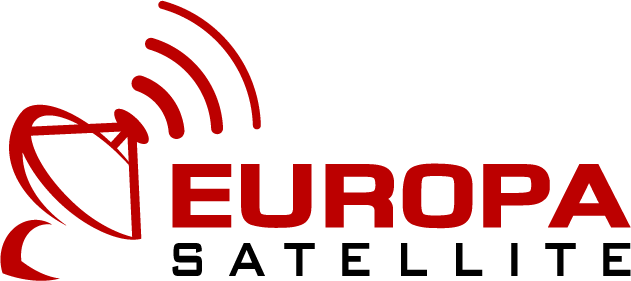Discover the world's most reliable satellite communication with Europa Satellite's extensive range of Satellite Phones. Featuring top brands like Iridium, Inmarsat, and Thuraya, our phones provide essential connectivity in the remotest areas. Whether you are an adventurer, a global traveler, or part of critical operations, our satellite phones ensure you stay connected with the world. Browse our diverse selection, from the rugged Iridium Extreme to the versatile Thuraya XT Pro, and find the perfect satellite communication solution for your needs.
-
 Iridium Beam TranSAT Whip Bundle (RST620B-WB)Sale Price: €2,565.54 €2,565.54
Iridium Beam TranSAT Whip Bundle (RST620B-WB)Sale Price: €2,565.54 €2,565.54 -
 ASE Premium Filtered Antenna Kit - 88 Meter (ASE-PFA88)€2,960.99 €2,960.99
ASE Premium Filtered Antenna Kit - 88 Meter (ASE-PFA88)€2,960.99 €2,960.99
Compare 5 Best Satellite Phones
 |
 |
 |
|||
| MODEL | THURAYA XT LITE | THURAYA XT PRO | IRIDIUM 9555 | IRIDIUM EXTREME | ISATPHONE 2 |
| NETWORK | THURAYA | THURAYA | IRIDIUM | IRIDIUM | INMARSAT |
| PHONE COST | US$499.95 | US$749.95 | US$1150.00 | US$1395.00 | US$899.95 |
| CONSTELLATION | 2 SATELLITES | 2 SATELLITES | 66 SATELLITES | 66 SATELLITES | 3 SATELLITES |
| USAGE AREA | EUROPE, AFRICA, ASIA, AUSTRALIA | EUROPE, AFRICA, ASIA, AUSTRALIA | 100% GLOBAL | 100% GLOBAL | GLOBAL (EXCEPT FOR POLAR REGIONS) |
| TALK TIME | UP TO 6 HOURS | UP TO 9 HOURS | UP TO 4 HOURS | UP TO 4 HOURS | UP TO 8 HOURS |
| STANDBY TIME | UP TO 80 HOURS | UP TO 100 HOURS | UP TO 30 HOURS | UP TO 30 HOURS | UP TO 160 HOURS |
| G.P.S. | NO | YES | NO | YES | YES |
| S.O.S. | NO | YES | NO | YES | YES |
| BLUETOOTH | NO | NO | NO | NO | YES |
| LENGTH | 128 mm | 140 mm | 143 mm | 140 mm | 169 mm |
| WIDTH | 53 mm | 60 mm | 55 mm | 60 mm | 75 mm |
| DEPTH | 27 mm | 27 mm | 30 mm | 27 mm | 36 mm |
| WEIGHT | 186 grams | 212 grams | 266 grams | 247 grams | 318 grams |
| OPERATING TEMPERATURES | -10°C to 55°C | -10°C to 55°C | -10°C to 55°C | -10°C to 55°C | -20°C to 55°C |
| IP RATING | N/A | IP65 | N/A | IP65 | IP65 |
| BUY NOW | BUY NOW | BUY NOW | BUY NOW | BUY NOW |
What is a Satellite Phone?
Satellite phones (sat phone, terminal, satellite cell phone) are mobile communication devices with standard phone capabilities which connect to stationary or orbiting satellites overhead. Compared to a cell phone, sat phones are bigger and heavier, and functionality is typically limited to voice calls and text messaging. They don’t offer smart high-end UX and front-end interface features like your smartphone, but technology is advancing and so is the design of satellite phones. Essentially, sat phones are designed to connect to a satellite (and bypass cellular networks) for the sole purpose of making a call or sending a short text-based message when it’s impossible to use a cell phone.
Let’s start with basic terrestrial technology – cell phones. A cell phone needs to connect to physical cellular towers to make calls, send texts or access internet services on mobile data. And, as most of us have experienced at one time or another, various elements can impact the signal strength of a cellular connection, specifically the distance from a cell tower. Enter the satellite phone.
However, satellite phones are not immune to outages albeit infrequent but natural phenomena such as solar flares can disrupt satellite communications. Also, some countries have a ban on satellite phone usage within their borders so its highly recommended to first check with the country you’re visiting.
Satellite Phone & Network Technology
Different satellite phone systems use different technologies, so these special phones are not interchangeable or have roaming functions with networks like a normal mobile device. Two main technologies used in satellite communications are geosynchronous satellites (GEO) and Low Earth Orbit (LEO) systems, and so different satellite phones have specific configurations.
LEO satellites orbit the Earth at a much lower distance providing enough opportunities to connect with your sat phone. With both LEO and GEO, the clearer the line of sight, the better the connection. These technologies are complex with pros and cons but having a basic understanding will help you make an informed decision whether you’re out to buy or look for a satellite phone rental.
Compare Satellite Phone Coverage Maps
| Iridium | Inmarsat | Thuraya |
|---|---|---|
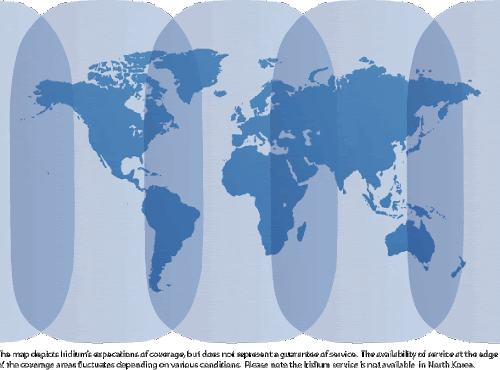 |
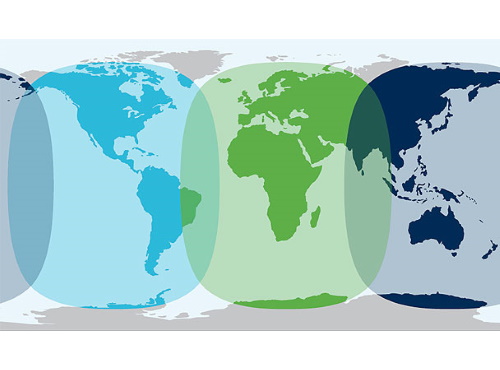 |
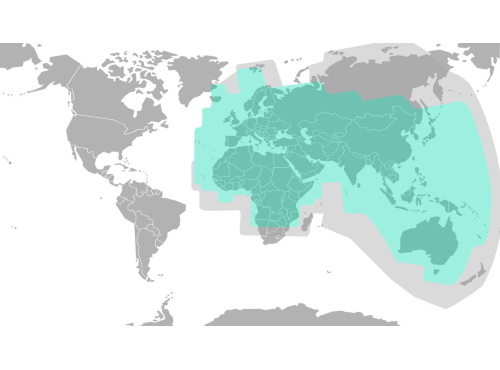 |
| 100% GLOBAL COVERAGE | GLOBAL COVERAGE EXCEPT FOR POLAR REGIONS | COVERAGE OVER EUROPE, AFRICA, ASIA, AUSTRALIA ONLY |
Satellite Phone Providers
Iridium, Inmarsat, Thuraya and Globalstar are the key players in the global satellite communications industry and their satellites all work differently. Iridium uses 66 satellites in Low Earth Orbit, while Globalstar has 18. Inmarsat and Thuraya both use geostationary satellites which orbit 35,786km (22,236 miles) above the Earth.
When using an Iridium sat phone, the satellites will move towards you (overhead) and with an Inmarsat or Thuraya phone, you will need to move towards the satellites. While Iridium seems to have an advantage of a guaranteed connection coming, there’s also a higher risk of call quality decreasing as the satellite passes and moves away from you. The connection with Inmarsat may then be more consistent once you’ve found it.
Iridium
Powered by a uniquely sophisticated global constellation of 66 cross-linked Low-Earth Orbit (LEO) satellites, the Iridium® network provides high-quality voice and data connections over the planet’s entire surface, including across airways, oceans, and polar regions. Iridium delivers an innovative and rich portfolio of reliable solutions for markets that require truly global communications.
Iridium completed a constellation upgrade in early 2019, replacing all its satellites and upgrading the supporting ground infrastructure. This enabled the launch of Iridium Certus®, a new multi-service platform delivering specialty broadband services, with additional midband services coming soon.
At only 780 kilometers from the Earth, the proximity of Iridium’s LEO network means pole-to-pole coverage, a shorter transmission path, stronger signals, lower latency, and shorter registration time than with GEO satellites. In space, each Iridium satellite is linked to up to four others creating a dynamic network that routes traffic among satellites to ensure global coverage, even where traditional local systems are unavailable.
Inmarsat
Inmarsat’s portable and fixed phone services provide essential voice calls and messaging for businesses operating in remote regions around the world. Suite of handheld, mobile and fixed services can be used on land, at sea and in the air. They utilise the world’s most advanced satellite communications network, offering clear voice quality and minimal call drop out.
Thuraya
Thuraya phones can connect to two GEO satellites positioned over Singapore and the east coast of Africa so it offers up to 70% coverage, which excludes Canada, US, South America and New Zealand.
Buying a Satellite Phone
Satellite phones are proprietary, made for a particular network and cannot be switched to other networks.The three main points to look at when buying a satellite phone is coverage, cost and functionality.
- In general, satellite phone communications average $1.50 per minute, and there are different satellite phone plans available that cover calls and support, but for occasional or emergency contact, the cost is irrelevant. The device can range anywhere from $800 to $2,000 with Iridium at the higher end and Thuraya at the lower cost range.
- The Iridium satellite constellation gets higher reviews for network and coverage and you pay a bit more for that, where Inmarsat sits somewhere in the middle with reasonable quality, coverage and cost. Consider Thuraya as a low-cost option if you are going near their two satellite locations.
- Certain features are important to different people and for different situations. Like Iridium offers great SOS features integrated with GEOS, while Inmarsat and Thuraya allows you to share your live location with a nominated contact.
Whichever satellite phone appeals to your pocket and your specific need, if you’re planning on visiting a remote area with minimal or no cell coverage, or you need an emergency backup communications device, then a satellite phone can prove to be extremely useful, if not lifesaving.
Satellite Phone Accessories
Various accessories are available for your satellite phones. These include spare batteries, antennas, docking stations, cases, chargers and more.
Satellite Phones in Vehicles
Satellite phones are designed to work only with a clear of the sky. The roof of a vehicle is typically enough to interfere with a satellite signal. In order to be able to use a satellite phone in a vehicle, you will typlically need a docking station for the sat phone and an antenna. The docking station or dock is where the satellite phone sits inside the vehicle and, depending on the model, can offer a plethora of features including hands-free, bluetooth, panic button, GPS tracking and more. An antenna is installed outside the vehicle and is connected to the docking station by an antenna cable. Depending on the antenna, the cable may be included or you might also need an antenna cable.
Satellite Phone Limitations
Trees, mountains, tall buildings are all natural enemies of satellite phones. Line of sight to the satellite is required to connect to a network and to make and receive calls. So if a satellite is behind a building, trees or a mountain, you will not be able to use a satellite phone.
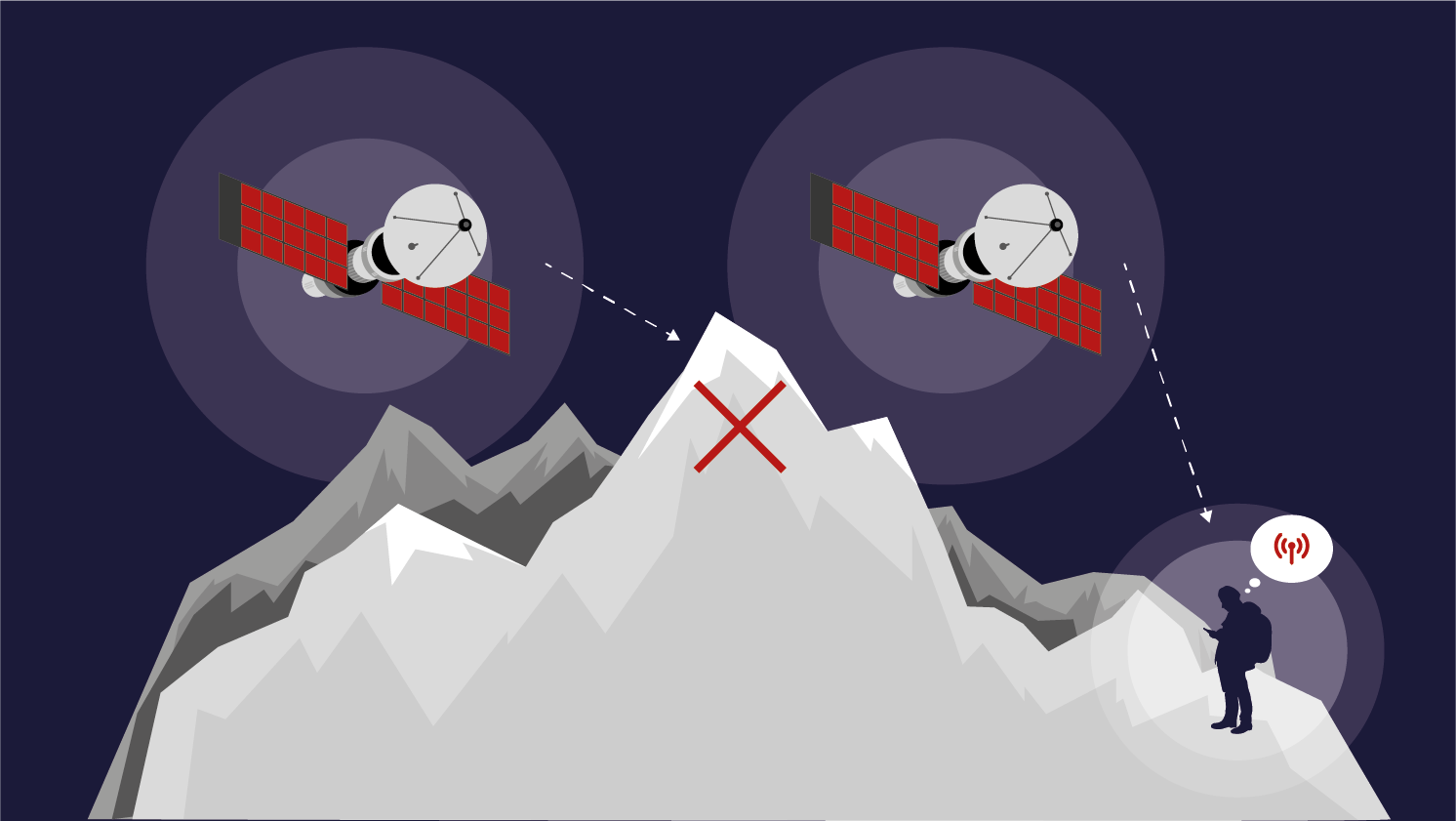
Countries where Satellite Phones are Restricted
A number of countries in the world have outlawed or banned satellite phones for various reasons. Following 2011 terror attacks in Mumbai, India banned the use of Iridium and Thuraya satellite phones. Those bringing in Iridium and Thuraya satellite phones to India, even on a layover, may be subject to arrest and imprisonment. INMARSAT satellite phones are allowed in India, but you will need permission from the Department of Telecommunications (DoT).
In Cuba, many electronics are prohibited, including satellite phones. You cannot bring or ship a satellite phone into Cuba unless you have a permit from the Cuban Ministry of Informatics and Communications. Cuba restricts the use of satellite phones because they’re seen as tools for subversive purposes; being caught with one can lead to arrest, time in prison, or an espionage charge.
Other countries or regions where satellite phones are restricted, embargoed, banned or illegal include Taliban controlled Afghanistan, Crimea region of Ukraine, Bangladesh, Chad, China, Iran, Libya, Myanmar, Nigeria, North Korea, Russia, Sri Lanka, Sudan, Thailand and Vietnam. This list can change at anytime, so please check with the country you are travelling to avoid unpleasant surprises at the border.
Satellite Phone FAQs
Do satellite phones have interent capabilities?
Most satellite phones offer internet access at speeds slower than dial-up. Remember dial-up? When the internet used to scream at you when connecting. Slower than that. While a satellite phone connection is still useful for certain applications, like downloading weather maps optimized for satellite phones, most users would find this to be painfully slow. We offer satellite internet terminals which have speeds around 100 times faster than a satellite phone and are made for a variery of applications including marine, portable, vehicular and fixed.
What are satellite phones?
Satellite phones are handheld (typically) communications devices allow you to communicate where cellular and landline networks are not availble.
Where are satellite phones used?
Satellite phones are typically used in remote areas or at sea. Satellite phones wouldn't typically work well in an urban area
Why are satellite phones used?
Satellite phones provide a form of communication where cellular networks dont reach or are not available.
Who uses satellite phones?
Anyone who works, lives or plays outside of cellular areas.
Can you use an Inmarsat plan on an Iridium phone or vice versa?
No, satelltie phones are proprietary and each phone network has its own selection of plans.
Telefoni Satelitor | Արբանյակային հեռախոս | Спадарожнікавы тэлефон | Satelitski telefon | Сателитен телефон | Telèfon per satèl·lit | Telefono Satellitare | Satelitski telefoni | Satelitní telefony | Satellit-telefoner | Satelliettelefoons | Satelliittelefonid | Satelliittipuhelimet | სატელიტური ტელეფონი | Satellitentelefon | Δορυφορικό τηλέφωνο | Műholdas telefon | Gervihnattasími | Fón Satailíte | Telefono satellitare | Satelīttālruņi | Palydoviniai telefonai | Satellitten Handyen | Сателитски телефони | Telefowns bis-Satellita | Satellitt-telefoner | Telefony satelitarne | Telefones por satélite | Telefoane prin satelit | Спутниковые телефоны | Сателитски телефони | Satelitné telefóny | Satelitski telefoni | Teléfonos satelitales | Satellit-telefoner | Uydu Telefonları | Супутникові телефони | Ffonau Lloeren | Satellite Phones | Satelitný telefón | Palydovinis Telefonas | Satelīta Telefons | Müholdas Telefonok | Telefoni Satellitari
